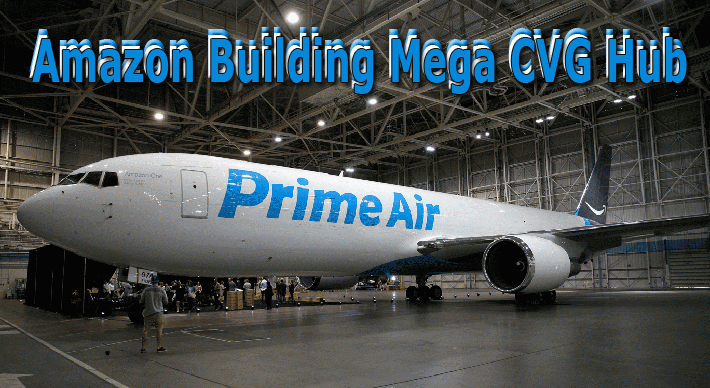
Amazon’s
ambitious supply chain infrastructure investments,
which have seen it build up a formidable
global network of warehouses, forwarding,
delivery, and air freight capacity at breakneck
pace are, to say the least, showing no signs
of slowing.
Hub
Cincinnati
 At the end of January the company announced
it would build a $1.49bn “centralized
air hub” at Cincinnati/Northern Kentucky
Airport (CVG) in Hebron, Kentucky, to “support
its growing fleet of Prime Air cargo planes”
and help the company meet customer demand
for fast, reliable deliveries.
At the end of January the company announced
it would build a $1.49bn “centralized
air hub” at Cincinnati/Northern Kentucky
Airport (CVG) in Hebron, Kentucky, to “support
its growing fleet of Prime Air cargo planes”
and help the company meet customer demand
for fast, reliable deliveries.
“As we considered
places for the long-term home for our air
hub operations, Hebron quickly rose to the
top of the list with a large, skilled workforce,
centralized location with great connectivity
to our nearby fulfillment locations, and
an excellent quality of living for employees,”
said Dave Clark, (right) Amazon
Senior Vice President of Worldwide Operations.
Opening
Not Set
Amazon, which has
not revealed when the hub will open, went
on to claim that Kentucky was an ideal location
given its already extensive shipping and
logistics industry.
The new hub will support its lease agreements
for 40 dedicated cargo airplanes that, in
turn, support its Prime delivery services.
Sweet
Sixteen Up & Away
“Today, 16
of those planes are in service for Amazon
customers with more planes rolling out over
time,” said a statement. “Amazon’s
Prime Air hub at CVG will support Amazon’s
dedicated fleet of Prime Air cargo planes
by loading, unloading, and sorting packages.”
Air
Road Everywhere
As Amazon noted,
the company is rapidly building out its
U.S. transport portfolio and capability,
not least via Amazon Flex, the company’s
mobile application that allows individuals
to sign-up, be vetted, and begin delivering
for Amazon.
The company also
operates a dedicated network of 4,000 trailers,
the aforementioned fleet or freighters and,
amongst other ventures, is now a licensed
forwarder in the U.S. and China.
“These efforts
join Amazon’s robust worldwide network
of 149 fulfillment centers and over 20 sortation
centers where the company uses algorithms,
robotics, machine learning, and other technological
innovations to increase delivery speeds
for customers,” said the company.
“Amazon is
now bringing the same technological expertise
to efforts in the transportation space to
increase shipping capacity for its customers.”
What
Is The End Game?
In a series of
award-winning articles last year, FlyingTypers tracked the range of possible
strategies one of the world’s most
innovative companies could be deploying
as it expands its global supply chain capabilities
while it simultaneously fills in its existing
infrastructure.
We questioned whether
Amazon was attempting to reduce its exposure
to transport costs levied by its integrator
partners, especially during peak season, or whether it was
in fact becoming a rival to transport incumbents
with a long-term plan of establishing new
supply chain profit centers using its existing
volumes to attract third-party business.
Ambition
& Money
 Amazon’s ambition and willingness
to put hard cash into fixed assets remains
undimmed, but its end-game is still hazy.
Although Amazon has said it aspires to supplement,
not replace, cargo carriers, many are not
convinced.
Amazon’s ambition and willingness
to put hard cash into fixed assets remains
undimmed, but its end-game is still hazy.
Although Amazon has said it aspires to supplement,
not replace, cargo carriers, many are not
convinced.
Indeed, most analysts
now believe that it will eventually become
a rival to 3PLs, integrators, airlines,
shipping lines, and forwarders in multiple
retail supply chain markets.
“We estimate
a $400 billion-plus market opportunity for
Amazon in delivery, freight forwarding,
and contract logistics,” Colin Sebastian,
an analyst for Baird Equity Research, said
in a note to clients.
“The 50 year
lease to build its first major air hub can
certainly be viewed as Amazon parking its
tanks on the respective lawns of the world’s
largest integrators.”
Size
Matters
 At 900 acres, the Ohio Amazon site
makes it close in size to equivalent hubs
UPS operates at Louisville and FedEx operates
at Memphis.
At 900 acres, the Ohio Amazon site
makes it close in size to equivalent hubs
UPS operates at Louisville and FedEx operates
at Memphis.
Cathy Roberson (right),
Founder and Head Analyst for Logistics Trends
& Insights, predicts further expansion
in the U.S.
“Amazon's
investment in an air hub is a clear indication
that they plan to not only handle their
own parcels but also compete head to head
with FedEx, UPS, and DHL,” she told FlyingTypers.
“There will
be an impact on FedEx and UPS in particular
within the U.S. domestic market in terms of
volume loss and profits.
“Amazon's
pick of CVG as a hub will likely create
a stir as they will be in close proximity
to DHL (at the same airport), FDX, and UPS
hubs and all will have to compete to attract
local talent for positions.”
She suggested additional
hubs would most likely be in the Dallas
area, with LA “if there’s space”
and Seattle suitable as West Coast locations.
Watch this space
for further news.
Sky King




 Vol.
16 No. 8
Vol.
16 No. 8 Vol.
16 No. 9
Vol.
16 No. 9